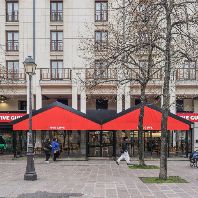Retail investment activity in Central and Eastern Europe (CEE) totaled around 630 million in the first half of 2010, a 190% increase compared to the same period last year. CEE retail investment activity has remained concentrated in Central Europe in H1 2010, with Hungary, Poland, Romania and Russia accounting for 87% of the CEE retail investment total, according to the latest research from CB Richard Ellis (CBRE).
For the first time since H2 2008, prime capital values for retail assets increased year-on-year (y-o-y) in CEE in H1 2010 in response to prime yield compression and increasing prime rents. However, the retail investment market is increasingly divergent, with the gap between prime and secondary markets growing.
Based on economic performance in the first quarter of 2010, most CEE countries are now out of recession, with some markets Poland, Romania and Hungary showing positive retail sales growth in recent months. Consumer confidence in Central Europe (CE) is on the rise as unemployment has started to decline and economic growth rates have turned positive. Nevertheless, recovery remains fragile and has had limited positive impact on consumer spending so far, with the announcement of government austerity measures likely to remain a risk to the recent improved confidence. Consumer confidence in South-Eastern Europe (SEE) has significantly deteriorated due to a much more challenging economic outlook.
The retail development pipeline in CEE has declined by 20% in the past six months. SEE countries, however, still await the delivery of a significant amount of new space, scheduled to come onto the market until the end of 2011. The Czech Republic has the highest shopping center provision rate (around 250 m²/1,000 inhabitants) in CEE. This relatively high provision is causing increased competition, which is visible in schemes not favorably located.
Countries like Bulgaria, Serbia and Croatia are some two years behind the development curve of the more emerged CEE retail markets and are as a result still in the middle of extensive supply growth. Despite the uncertain outlook, construction is still moving ahead in many of the capital and regional cities across these countries. As a result, shopping center provision rates are likely to increase significantly here. Given this is occurring during a period of increasing pressure on consumers and limited retailer demand, it is likely to result in increased pressure on the retail structures in these markets.
Prime shopping center rents remained mainly stable across CEE in H1 2010. Prime rents in Eastern European (EE) capitals have, however, increased considerably. Rents increased for the third quarter in a row in EE and are 10-15% above the levels recorded in H1 2009. The significant changes in EE are a result of a better economic outlook combined with the more volatile character of these markets. The majority of CE capitals witnessed prime yield compression of 10-25 basis points (bps) in H1 2010, while prime yields in Kyiv and St. Petersburg dropped by 100-200 bps after dramatic softening during th
Based on economic performance in the first quarter of 2010, most CEE countries are now out of recession, with some markets Poland, Romania and Hungary showing positive retail sales growth in recent months. Consumer confidence in Central Europe (CE) is on the rise as unemployment has started to decline and economic growth rates have turned positive. Nevertheless, recovery remains fragile and has had limited positive impact on consumer spending so far, with the announcement of government austerity measures likely to remain a risk to the recent improved confidence. Consumer confidence in South-Eastern Europe (SEE) has significantly deteriorated due to a much more challenging economic outlook.
The retail development pipeline in CEE has declined by 20% in the past six months. SEE countries, however, still await the delivery of a significant amount of new space, scheduled to come onto the market until the end of 2011. The Czech Republic has the highest shopping center provision rate (around 250 m²/1,000 inhabitants) in CEE. This relatively high provision is causing increased competition, which is visible in schemes not favorably located.
Countries like Bulgaria, Serbia and Croatia are some two years behind the development curve of the more emerged CEE retail markets and are as a result still in the middle of extensive supply growth. Despite the uncertain outlook, construction is still moving ahead in many of the capital and regional cities across these countries. As a result, shopping center provision rates are likely to increase significantly here. Given this is occurring during a period of increasing pressure on consumers and limited retailer demand, it is likely to result in increased pressure on the retail structures in these markets.
Prime shopping center rents remained mainly stable across CEE in H1 2010. Prime rents in Eastern European (EE) capitals have, however, increased considerably. Rents increased for the third quarter in a row in EE and are 10-15% above the levels recorded in H1 2009. The significant changes in EE are a result of a better economic outlook combined with the more volatile character of these markets. The majority of CE capitals witnessed prime yield compression of 10-25 basis points (bps) in H1 2010, while prime yields in Kyiv and St. Petersburg dropped by 100-200 bps after dramatic softening during th















